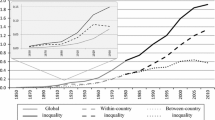Abstract
The results of new direct price level comparisons across 146 countries in 2005 have led to large revisions of PPP (purchasing power parity) exchanges rates, particularly for China and India. The recalculations of international and global inequalities, using the new PPPs, show that inequalities are substantially higher than previously thought. Inequality between global citizens is estimated at 70 Gini points rather than 65 as before. This high level of inequality is confirmed by the results obtained from the new set of 122 national household surveys from around year 2005.
Similar content being viewed by others
References
Ackland, R., Dowrick, S., Freyens, B.: Measuring Global Poverty: Why PPPs Matter. Australian National University Department of Economics, mimeograph. Available at http://voson.anu.edu.au/papers/GlobalPoverty_17Sep2008.pdf (2008)
Ahluwalia, M.S., Carter, N.G., Chenery, H.B.: Growth and poverty in developing countries. J. Dev. Econ. 6, 299–341 (1979)
Ahmed, S.: International Comparison of Chinese Prices. Unpublished World Bank working paper, World Bank: Comparative Analysis and Data Division, Washington, D.C. (1983)
Australian Bureau of Statistics: The International Comparison Program and purchasing power parities. Available at http://siteresources.worldbank.org/ICPINT/Resources/internationalppp_AUS.pdf (2006)
Anand, S., Segal, P.: What do we know about global income inequality? J. Econ. Lit. 46(1), 57–94 (2007)
Berry, A., Bourguignon, F., Morrisson, C.: Changes in the world distribution of income between 1950 and 1977. Econ. J. 93, 331–50 (1983)
Chen, S., Ravallion, M.: China is Poorer than we Thought, but no Less Successful in the Fight Against Poverty. Policy Research Working Paper No. 4621, May (2008)
Chen, S., Ravallion, M.: The Developing World is Poorer than we Thought, but no Less Successful in the Fight Against Poverty. World Bank Policy Research Working Paper No. 4703, August. Forthcoming in Quarterly Journal of Economics, vol. 125(4), p. 2010 (2008)
Davies, J.M., Shorrocks, A.F.: Optimal grouping of income and wealth data. J. Econom. 42, 97–108 (1989)
Deaton, A.: Measuring poverty in a growing world (or measuring growth in a poor world). Rev. Econ. Stat. 1, 1–19 (2005)
Deaton, A.: Price indexes, inequality, and the measurement of world poverty. AEA Presidential Address. Am. Econ. Rev. 100(1), 5–34 (2010)
Deaton, A., Heston, A.: Understanding PPPs and PPP-Based National Accounts. Research Program on Development Studies, Princeton University (2009)
Dowrick, S., Akmal, M.: Contradictory trends in global income inequality: a tale of two biases. Rev. Income Wealth 51(2), 201–230 (2005)
Grosh, M.E., Nafziger, E.W.: The computation of world income distribution. Econ. Dev. Cult. Change 34, 347–359 (1986)
Heston, A.: Treatment of China in PWT 6.1. Available http://pwt.econ.upenn.edu/ (2001)
Holtz, C.A.: China’s reform period economic growth: how reliable are Angus Maddison’s estimates. Rev. Income Wealth 52(1), 85–119 (2006)
Holtz, C., Brand, L.: Spatial price estimates and price differences in China: estimates and implications. Econ. Dev. Cult. Change 55(1), 43–86 (2006)
Li, Hongyi., Squire, L., Zou, Heng-fu.: Explaining international and intertemporal variations in income inequality. Econ. J. 108, 26–43 (1998)
Joliffe, D., Krushelnytskyy, B.: Bootstrap standard errors for indices of inequality: INEQERR. Available at http://users.starpower.net/djolliffe/stb/ineqerr.pdf (n.d.)
Maddison, A.: Chinese Economic Performance in the Long Run. OECD Development Centre, Paris (1998)
Maddison, A.: The World Economy: Historical Statistics. OECD Development Centre Studies, Paris (2003)
Maddison, A.: Measuring the economic performance of transition economies: some lessons from Chinese experience. Rev. Income Wealth 55, 423–441 (2009)
Milanovic, B.: True world income distribution, 1988 and 1993: first calculation based on household surveys alone. Econ. J. 112(476), 51–92 (2002)
Milanovic, B.: Worlds Apart: Measuring International and Global Inequality. Princeton University Press, Princeton (2005)
Milanovic, B.: Why did the Poorest Countries Fail to Catch up? Carnegie Working Paper No. 62, September (2005)
Milanovic, B.: Global income inequality: what it is and why it matters. World Econ. 7(1), 131–153 (2006)
Milanovic, B.: An even higher global inequality than previously thought: a note on global inequality calculations using the 2005 International Comparison Program results. Int. J. Health Serv. 38(3), 421–429 (2008)
Minoiu, C., Reddy, S.: Real income stagnation of countries: 1960–2001. J. Dev. Stud. 45(1), 1–23 (2009)
Pritchett, L.: Divergence, big time. J. Econ. Perspect. 11(3), 3–17 (1997)
Ravallion, M.: Should poverty measures be anchored to the national accounts? Econ. Polit. Wkly. 34, 3245–3252 (2000)
Ravallion, M., Chen, S.: China’s (Uneven) Progress Against Poverty. Policy Research Working Paper No. 3408, September (2004)
Ravallion, M., Chen, S., Sangraula, P.: Dollar a Day Revisited. World Bank Policy Research Working Paper No. 4620, May (2008)
Ruoen, R., Chen, K.: China’s GDP in U.S. Dollars Based on Purchasing Power Parity. Policy Research Working Paper No. 1415 (1995)
Theil, H.: World income inequality and its components. Econ. Lett. 2(1), 99–102 (1989)
van Ourti, T., Clarke, P.: A simple correction to remove the bias of the Gini coefficient due to grouping. Rev. Econ. Stat. (2010, in press)
World Bank: World Development Report 2006: Equity and Development. Oxford University Press and the World Bank, Washington (2006)
World Bank: Global Purchasing Power: Parities and Real Expenditures, 2005 International Comparison Program. World Bank, Washington (2008)
Yao, S., Zhu, L.: Understanding income inequality in China: a multi-angle perspective. Econ. Plan. 31(2–3), 133–150 (1998)
Author information
Authors and Affiliations
Corresponding author
Additional information
I am grateful for comments to Yuri Dikhonov, Peter Lanjouw, Thomas Pogge, editor of this Journal Jean-Yves Duclos and two anonymous referees. The views expressed are those of the author and should not be attributed to the World Bank or its affiliated organizations.
Rights and permissions
About this article
Cite this article
Milanovic, B. Global inequality recalculated and updated: the effect of new PPP estimates on global inequality and 2005 estimates. J Econ Inequal 10, 1–18 (2012). https://doi.org/10.1007/s10888-010-9155-y
Received:
Accepted:
Published:
Issue Date:
DOI: https://doi.org/10.1007/s10888-010-9155-y




